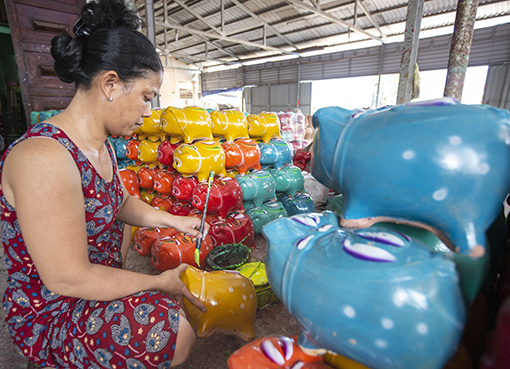Traditional craft villages boldly invest in technology and innovation
In the province, ceramics, lacquer, wood carving, knitting, and piggy-bank making villages were formed, have developed for a long time and become traditional handicraft industries of the province. In the current condition, in order to preserve and develop, handicraft villages have been innovating step by step, investing heavily in production technology to have high-quality products suitable to market demands.
A one-time flourishing period
At wood carving village in An Thanh Ward (Thuan An town), Phu Tho Ward (Thu Dau Mot City), artisan Huynh Trung Thu (Thanh Loc quarter, An Thanh ward), recalled that the 1990s was considered as the flourishing period of Binh Duong wood carving. The design of Binh Duong wooden sculptures was quite diverse. Ancient styles were created and preserved by artisans in products such as Buddha statues, and some were made-to-order for customers. The products were mainly supplied to the domestic market, most of them were fine-art products sold to tourists as souvenirs, sold in hotels, cultural – tourist spots; some products were exported.

In order to preserve craft villages, production facilities in the province have changed product models and production methods. In photo: A stage of piggy bank production at a facility in Lai Thieu Ward, Thuan An Town.
Referring to lacquer, many people have associated with Tuong Binh Hiep lacquer, a famous brand name, especially in the 1945-1975 period. In particular, Thanh Le lacquer workshop was established 1943 and the largest production establishment at that time, earned good reputation on domestic and foreign markets.
Le Ba Linh (Tu Bon), owner of Tu Bon lacquer production, said that in 2011, Tuong Binh Hiep lacquer craft village had had 900 households with about 3,000 workers making lacquer, creating an annual export value of nearly 1 million USD. In that year, lacquer products here were mainly exported to European countries, with great commercial values, peaking in quantity, with high artistic quality, diverse models.
To improve product quality for development
Along with the development, the demand and taste of customers has changed. In recent years, many craft villages in the province have faced many difficulties, the number of artisans and households decreased. Recently, wood carving profession in the province faced many difficulties. The number of people who are attached to this profession is not much; products are mainly processed, not mass production as before.
In Lac An commune, North Tan Uyen district, there were more than 50 households in traditional handicraft village of bamboo and rattan weaving. But now the number is only 15 households. According to families here, the reasons for many households to quit their jobs are mainly the increase in raw material prices, but no increase in product prices, leading to losses. If product price increased, it could not compete on the market.
In order to preserve craft villages, many production facilities in the province have boldly changed product models, machinery, and focused on the domestic market, especially the segment of souvenirs. It is noted that most craft villages in the province invested in new machinery and equipment in production. Artisan Le Ai Huynh (Quarter 3, Phu Tho Ward), said that at present, almost wooden handicraft products of craft villages in the province were mainly produced in industrial form. Therefore, in order to live on this profession, they boldly innovated from method to pattern... to create a difference, attract customers.
An owner of a piggy-bank production facility in Lai Thieu Ward, Thuan An Town, said to maintain their market, her production facility had to create many models and designs. Their products are attracting a large number of customers, although the price is higher than traditional piggy banks.
Reported by Khanh Dang – Translated by Ngoc Huynh
- Impressions on the development journey (25/04)
- Ben Cat Town awards certificates of 12 typical rural industrial products in 2024 (25/04)
- Binh Duong Customs Department holds dialogue meeting with Korean businesses (25/04)
- Businesses concerned about rising exchange rate pressure (24/04)
- Q1-2024, provincial socio-economic situation continues to have positive changes (24/04)
- Policy credit requires local entrusted capital source to balance (23/04)
- Creating favorable conditions for social housing buyers (23/04)
- Giant Group pours additional US$ 120 million into Binh Duong (23/04)
 Binh Duong Customs Department holds dialogue meeting with Korean businesses
Binh Duong Customs Department holds dialogue meeting with Korean businesses
 Impressions on the development journey
Impressions on the development journey
 Businesses concerned about rising exchange rate pressure
Businesses concerned about rising exchange rate pressure
 Policy credit requires local entrusted capital source to balance
Policy credit requires local entrusted capital source to balance
 Thuan An city in striving to fulfill type-1 urban criteria
Thuan An city in striving to fulfill type-1 urban criteria
 Local real estate market strongly attracts foreign investors
Local real estate market strongly attracts foreign investors
 Firm steps of reforms
Firm steps of reforms
 Provincial enterprises are ready to join the global supply chain
Provincial enterprises are ready to join the global supply chain
 Infrastructure planning to develop modern ecosystem of modern logistics
Infrastructure planning to develop modern ecosystem of modern logistics
 Deputy Prime Minister Tran Hong Ha: Binh Duong will open a new era of green, sustainable energy development
Deputy Prime Minister Tran Hong Ha: Binh Duong will open a new era of green, sustainable energy development




